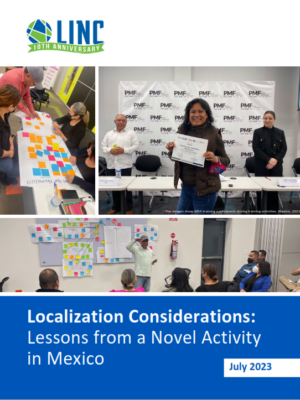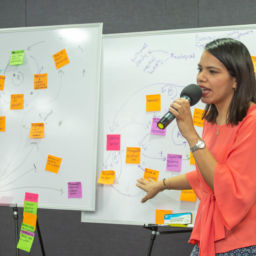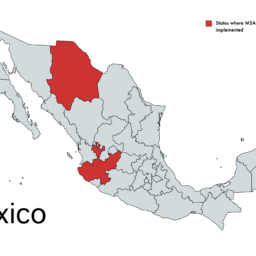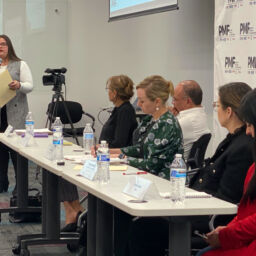As a pioneer of locally led development, LINC strives to look for opportunities for learning and improving our localization efforts. This report is a result of that.
In the “Localization Considerations: Lessons from a Novel Activity in Mexico” report, we share learnings and recommendations from a recent USAID activity in Mexico that was designed, funded, and implemented by a diverse consortium of Mexican and international partners. As such, it served as a use case for how to promote localization in USAID’s portfolio and put national stakeholders in the lead.
The report highlights some of our key findings from the activity, and specific recommendations to help development stakeholders continue to advance locally led development.
Executive Summary
Within the broader context of increasing localization of international development, this study sought to distill lessons learned about the challenges of localization using the USAID/Mexico Multi-Stakeholder Strengthening Activity (MSA) as a case study. MSA was a unique USAID activity that was designed, funded, and implemented by a diverse consortium of partners at the national and international level, including: (i) USAID/Mexico; (ii) two Mexican resource partners, Fideicomiso para la Competitividad y Seguridad Ciudadana de Ciudad Juarez (FICOSEC, “The Trust for Competitiveness and Citizen Security in Ciudad Juarez”) and Corporativa de Fundaciones A.C. (Corporativa, “The Foundations Corporation”); (iii) US-based small business, LINC; and (iv) Mexican implementing partner Asamblea de Organizaciones (“The Assembly of Organizations”). The program was funded in equal amounts by USAID and the Mexican resource partners.
During its 27-month period of performance (August 2020-November 2022), MSA increased trust and collaboration among Mexico’s private sector, civil society, and government to effectively address problems affecting communities related to crime and violence prevention, criminal justice systems, and human rights. MSA did this by using a collective action approach, grounded in systems thinking, that strengthened the capacities of civil society organizations (CSOs), local government, and private sector actors, to identify, prioritize, and address priority issues through improved transparency, strengthened accountability to their communities, and collaboration in multi-stakeholder dialogues.
What made the project so unique was that the design and approach to project implementation represented an intentional effort to deviate from the traditional roles of participating organizations, with USAID engaging in co-design with national stakeholders, LINC serving as a facilitator and coordinator, Mexican resource partners providing funding and strategic input, and Mexican organizations leading implementation. As such, it served as a use case for how to promote localization in USAID’s portfolio and put national stakeholders in the lead. It also highlights some of the key challenges to achieving localization from the point of view of each set of stakeholders involved.
Note: Throughout this report we use the term “national” as opposed to “local” to refer to Mexican organizations.
As part of MSA’s unique collaboration model, FICOSEC and Corporativa contributed leveraged funds to the project while simultaneously receiving funds from USAID and working as project implementers and subawardees to LINC, the prime awardee, who coordinated and facilitated the activity.
LINC conducted this study in three phases between the months of October 2022-January 2023 and included: (1) desk review, (2) key informant interviews, and (3) analysis. It was guided by three overarching research questions:
- How did the relationships between the implementing organizations positively or negatively affect MSA implementation? What changes, if any, could have been made to facilitate more effective collaboration between the three organizations?
- How did USAID’s policies and procedures for technical and financial reporting positively or negatively affect MSA implementation and collaboration between the implementing organizations? What changes to policies and procedures, if any, could have facilitated MSA implementation and/or decreased the reporting burden on national partners with more limited USAID experience?
- What factors, if any, limited national organizations’ ability to take ownership over MSA’s design and implementation? What could donors (USAID) and international NGOs/contractors (LINC), and national organizations do differently to facilitate increased ownership by national organizations?
Analysis of MSA documents and key informant interviews led to the following findings and recommendations:
Findings
- Early engagement promotes ownership.
Engaging national partners early in MSA’s project design led the partners to feel a strong sense of ownership over project design and implementation.
- Administrative inflexibility creates tension.
The inflexibility of both the timeline for project implementation and the requirements for reporting, especially financial, resulted in tensions between implementing organizations and frustration on the part of national partners.
- Power dynamics are an obstacle.
Though all partners emphasized the importance of horizontal management rather than the typical vertical relationship between funders, prime awardee, and subawardees(s), misunderstandings of who was imposing reporting requirements led Mexican partners to feel like others were trying to impose traditional prime/sub hierarchies.
4. Communication is key.
Clear and open communication between all funders and implementers is vital for setting expectations, defining roles and responsibilities, avoiding and clarifying misunderstandings, and overall successful implementation of projects.
5. Compliance questions can be sensitive.
While USAID projects require extensive documentation and compliance verification – requirements which traditional implementers are familiar with – they may be deemed as intrusive or demeaning to newer partners. Particularly when coupled with the power dynamics described above, they can complicate efforts to build trust and establish strong relationships.
6. USAID has an important role to play.
Increasing USAID’s work with national organizations will undoubtedly require more, and deeper, engagement than USAID currently devotes to traditional implementing partners.
Recommendations
- Invest in the up-front work.
Invest more time and resources during project design and early phases of implementation to properly align expectations, define roles and responsibilities, and provide any guidance and training national partners may need to comply with award requirements. This support can be foundational for eventual success.
- Embrace flexibility.
Increase donor flexibility in all areas for future awards that include national partners. This should include the intentional selection of award/contract mechanisms, and increased flexibility in donor reporting requirements, rules for communication, timelines for implementation, and modifications.
- Reimagine the role of the prime.
USAID typically requires a single prime implementer to receive the award, and to be the primary point of contact on communications and the responsible party on the award. However, this can undermine a truly collaborative consortium, especially among multiple national partners who need to work together to address large, complex development problems. Explore ways this could work differently, for instance where there might be an informal alliance/association of one or more national partners that could sign an award with USAID.
4. Shorten the learning curve.
Offer ongoing compliance and reporting support to national partners, with time and budget intentionally allocated. This can take many shapes and forms.
5. Continue to engage national partners in co-designing future awards.
Meaningful engagement with and integration of national voices – through co-creation and other participatory design methods – will lead to better and more sustainable development programming. It is also an important step to build trust, which is crucial for effective partnerships. And co-design should not only happen at project start, but rather be an ongoing process throughout implementation.




